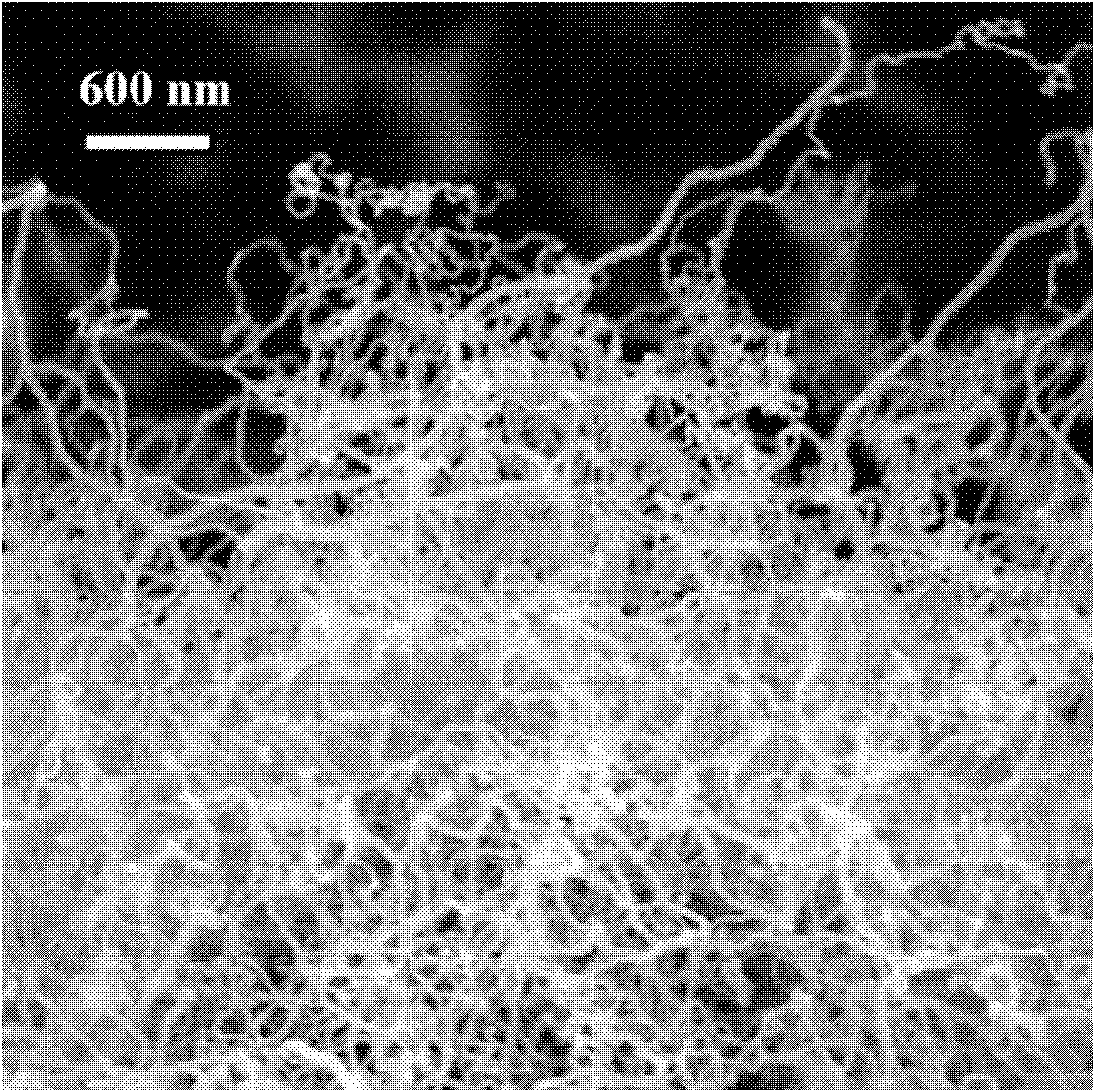Method for synthesis of carbon nanostructure material by using organic material
A carbon nanostructure and nanostructure technology, which is applied in the field of preparation of carbon nanostructure materials, achieves the effect of simple method, low cost and sufficient raw materials
- Summary
- Abstract
- Description
- Claims
- Application Information
AI Technical Summary
Problems solved by technology
Method used
Image
Examples
Embodiment 1
[0032] Set the temperature in the high-temperature cracking furnace to 300°C, place the quartz tube in the furnace, and feed 5 liters of argon (or carbon dioxide) per minute into the tube as an inert gas. Cut 1 gram of waste plastic bottle caps made of polypropylene into strips of 20×60 mm, place them in a quartz tube, and pyrolyze them in an oxygen-isolated environment.
[0033] Solid high-density polypropylene undergoes pyrolysis and is completely decomposed into a mixture of gaseous hydrocarbons with high calorific value, the main components of which are methane, ethane, ethylene, propane, propylene and acetylene. After the mixture is fully mixed with one or more mixed gases of oxygen, nitrogen, argon, carbon dioxide, and water vapor in the venturi tube at the end of the quartz tube, it is automatically ignited at high temperature to produce 12% carbon dioxide, 20% carbon monoxide and 8% hydrogen.
[0034] After the combustion reaction is finished, the combustion product i...
Embodiment 2
[0038] Set the temperature in the high-temperature cracking furnace to 600 °C, place the quartz tube in the furnace, and feed 3 liters of argon (or carbon dioxide) per minute into the tube as an inert gas. 4 grams of bagasse fibers were crushed into particles with a size below 500 microns and placed in a quartz tube to be pyrolyzed in an oxygen-free environment.
[0039] The solid bagasse fiber is pyrolyzed and completely decomposed into a mixture of gaseous hydrocarbons with high calorific value, the main components of which are carbon monoxide, methane, ethylene, ethane and acetylene. One or more mixed gases of hydrogen, nitrogen, argon, carbon dioxide, and water vapor are introduced into the Venturi tube to fully dilute the pyrolysis gas, and then lead it into a filter, and the introduced gas Filtration is performed to obtain reaction gas for synthesizing carbon nanomaterials.
[0040] Another quartz tube preheated to 900 °C is placed at the output end of the filter. In th...
Embodiment 3
[0043] Set the temperature in the high-temperature cracking furnace to 600 °C, place the quartz tube in the furnace, and feed 3 liters of argon (or carbon dioxide) per minute into the tube as an inert gas. 4 grams of bagasse fibers were crushed into particles with a size below 500 microns and placed in a quartz tube to be pyrolyzed in an oxygen-free environment.
[0044] The solid bagasse fiber is pyrolyzed and completely decomposed into a mixture of gaseous hydrocarbons with high calorific value, the main components of which are carbon monoxide, methane, ethylene, ethane and acetylene. One or more mixed gases of hydrogen, nitrogen, argon, carbon dioxide, and water vapor are introduced into the Venturi tube to fully dilute the pyrolysis gas, and then lead it into a filter, and the introduced gas Filtration is performed to obtain reaction gas for synthesizing carbon nanomaterials.
[0045] Another quartz tube preheated to 1050 °C is placed at the output end of the filter. In t...
PUM
| Property | Measurement | Unit |
|---|---|---|
| diameter | aaaaa | aaaaa |
| length | aaaaa | aaaaa |
Abstract
Description
Claims
Application Information
 Login to View More
Login to View More - R&D
- Intellectual Property
- Life Sciences
- Materials
- Tech Scout
- Unparalleled Data Quality
- Higher Quality Content
- 60% Fewer Hallucinations
Browse by: Latest US Patents, China's latest patents, Technical Efficacy Thesaurus, Application Domain, Technology Topic, Popular Technical Reports.
© 2025 PatSnap. All rights reserved.Legal|Privacy policy|Modern Slavery Act Transparency Statement|Sitemap|About US| Contact US: help@patsnap.com



